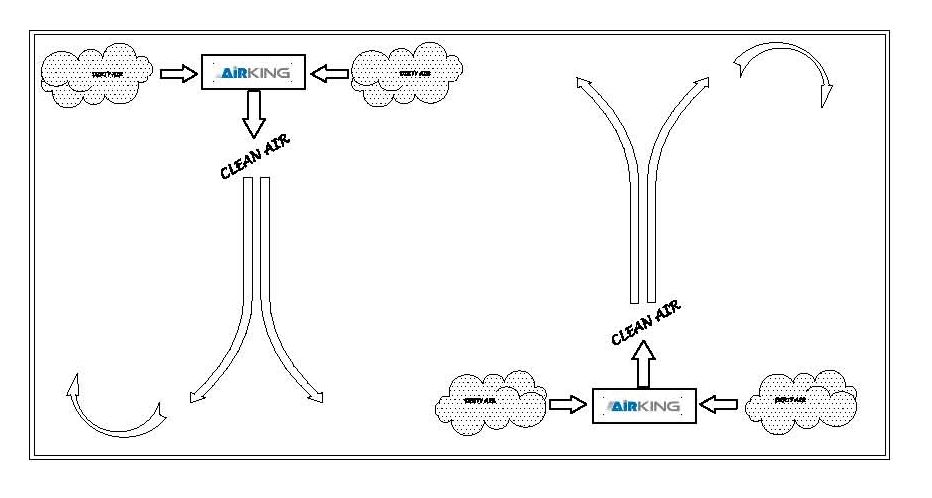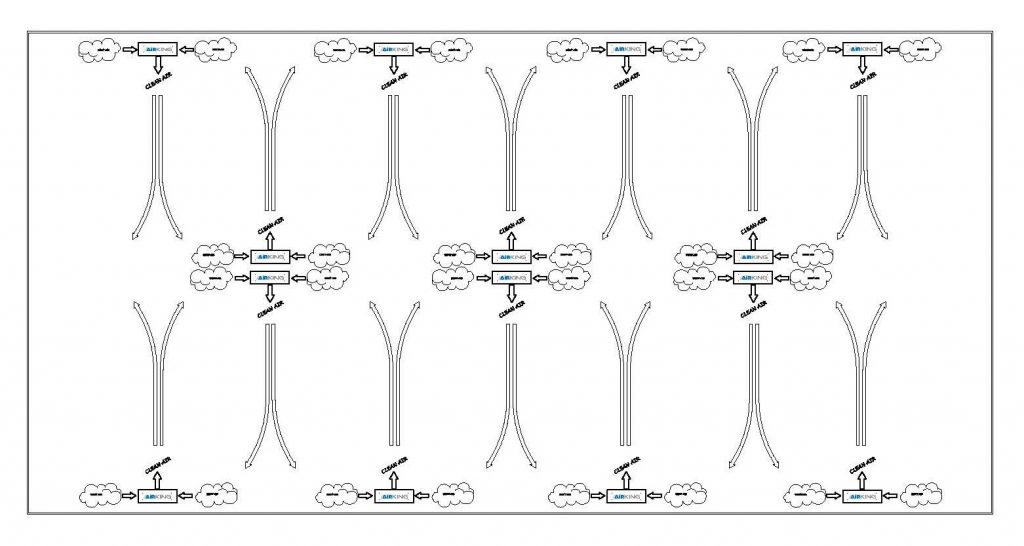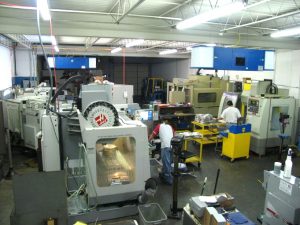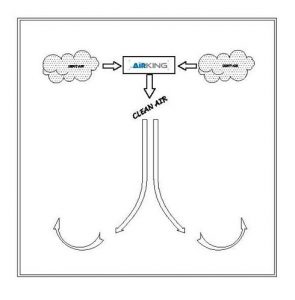FAQs
Ambient Air Filtration
What is ambient air filtration?
Ambient air filtration is the filtering and cleaning of the surrounding air in an open unconfined room or given area. Contaminates in an open area can be composed of many different pollutants including dust, smoke, welding fumes, coolant, oil mist, and more. There are basically two forms of air filtration in the manufacturing work environment. They are ambient air filtration and source capture. Many facilities use a combination of both. Any time you can capture at the source it is more efficient and best to do so. This is very efficient and importantly, keeps the pollutants out of the breathing zone. In practice, however, ambient air filtration is often used in conjunction with source capture air cleaning. In many facilities, you will find mist collectors on machine tools for source capture and ambient air cleaners cleaning the background area.
How does it work?
Ambient air cleaning is simply cleaning the surrounding air using one or a series of air cleaning units positioned in the work area such that they set up an appropriate airflow pattern to maximize air cleaning efficiency. The air cleaning unit consists of a cabinet, impeller or blower, and filter bays to house the various filters. These units are generally sized according to the cubic feet per minute (cfm) of free air they are designed to move. Free air is the cfm the blower or air cleaner will produce without any filter or restrictions. The filter retention levels of the various filters are designated by their IVUrRV levels. For more information on filters refer to our Filter Selection Guide here.
How do I determine the number of air cleaners I will need for my shop?
Air cleaners are sized by their capacity in cubic feet per minute (CFM). In order to determine the number of air cleaners required for your shop: 1. Determine the size of the shop area in cubic feet. We then multiply that number by the desired number of air changes per hour. 2. Next multiply the cfm of the selected air cleaner times 60 minutes to give you the cfm per hour. Divide that number into the product arrived at in step 1. The result is the number of air cleaners required.
As a formula it can be expressed as:
L x W x H of the area under consideration x # of air changes per hour
cfm of the air cleaner x 60 minutes
The result is the required number of air cleaners for that particular air cleaner size. Keep in mind that the number of air cleaners required for your application can depend on several additional factors such as whether you have any source capture on equipment in the shop, the complexity of the application, other process in the area etc. As a general guideline, the following offers a starting point in the evaluation:
Light Contamination Level: 5 – 6 air changes per hour
Average Contamination Level 8– 10 air changes per hour
Heavy Contamination Level 12– 13 air changes per hour
Where do I locate the air cleaners?
Placement of the air cleaners depends on the dimensions of the work area. The following three examples
are based on using the Air King Model 30 units which set up a “T” air flow pattern.

Small Rectangular Work Area

Large Work Area
What are the benefits of air filtration? Filter or exhaust?
The benefits of a well-thought-out air filtration system are numerous. First, it provides employees with a healthier work environment. In manufacturing facilities, pollutants in the air can include dust, fumes oil mist droplets, and more depending on what other air circulation/air handling equipment is in use. In some cases, pollutants can migrate throughout a facility. Thus, air filtration systems can provide a healthy more productive workplace. In machine shops, the use of air filtration equipment can eliminate oily work surfaces and floors making the workplace safer from slips and falls. The use of air filtration systems can reduce energy costs as well. Recirculating filtered air in a facility can reduce heating costs in the winter and cooling costs in the summer. In addition, depending on your conditions and what is in your air, there may be environmental regulations involved in exhausting shop air as well.
Mist Collectors
What is oil/coolant mist and how is it generated and dispersed in a machine shop?
Oil and coolant mist is generated by CNC machine tools including CNC Swiss machines, lathes, mills, grinders, and other machine tools. This mist can be generated due to coolant/oil atomization in the machining process, high pressure coolant delivery systems, the machining operation itself or coolant deflection from nozzle direction to name a few. This atomized oil/coolant escapes the machine tool cabinet and is dispersed into the atmosphere.
Why should I add mist collectors to my shop and what does it do?
If you are running CNC machine tools in your shop you need mist collection. If you are using high pressure coolant delivery systems, your need for mist collectors increases exponentially. Extreme atomization of coolant and oil mist can create shop health issues for employees as well as a less than desirable workplace. Depending on the machining application the severity of oil or coolant mist can widely vary. Oil or coolant mist in the work environment can create an unhealthy work space, contribute to slippery floors and industrial accidents, reduce productivity and more.
Is it important that my mist collector be effective on smoke?
It certainly is if your machine tool is generating smoke or may generate smoke due to future new machining applications. Heavy cuts on hard materials will produce smoke. Electrostatic technology in a mist collector is very effective on smoke. Smoke can also be handled with a HEPA Post filter that can be attached after the last filtration stage. You want to have a mist collector with that capability.
Why should I have a mist collector on my machine tools?
If you have a CNC machine tool with no mist collection the potential exists for you to create an unhealthy work environment and hazardous shop area. This can lead to employee health issues, slippery floors creating safety issues, industrial accidents and a loss of productivity. Oil mist will tend to coat the floors, machine tools, light fixtures, clog HVAC systems and hang in the atmosphere.
What are the most common types of mist collectors?
The most common types of mist collectors are electrostatic, media and centrifugal. Electrostatic mist collectors utilize electrostatic technology for the collection of mist, smoke, submicron contaminates and other particulate using high voltage ionizing wires and collection plates. Media mist collectors utilize barrier technology, an air filter in the air stream. These filters must be replaced when dirty. Centrifugal mist collectors operate using centrifugal force. They spin the filter elements which trap the mist and agglomerate it into larger droplets. The larger droplets are spun out onto the wall of the drum where they are collected and drained. For a more detailed discussion of the types of mist collectors see Selecting A CNC Mist Collector.
What are the benefits of a HEPA Post Filter on my mist collector?
Increasingly, more and more HEPA High Efficiency Post Filters are being used as final phase polishing filters in shops with machine tool applications. As we strive to achieve improved environmental working conditions this usage will probably increase. In many facilities, cleanliness is a very high priority for example the medical industry & medical implants, aerospace, and subminiature machine parts. These facilities require a clean environment. A HEPA post filter has the capability to filter down to 99.97% DOP @ 0.3 micron. Smoke and mist contain particulate. If you incorporate a HEPA post filter on your mist collector it is in your best interests to perform regular periodic maintenance. You do not want your HEPA filter to become the main filter. It is for final phase filtration and polishing of the discharged air from the mist collector.
What are the benefits of having a mist collector?
- Increased Productivity
- Decreased Fire Risk
- Clean Air in the Shop
- Reduced Coolant Loss
- Reduce Employee Health Risks
- Cleaner HVAC Systems
- Cleaner Floors and Shop Environment
Summary
When evaluating your air filtration needs take an inventory of the operations in your facility such as CNC, welding, grinding, etc. What processes are conducive to source capture air filtration? You may want to focus on the biggest sources of pollution to start off with and then build on that with additional ambient air filtration in the future. Your investment will result in a cleaner environment, healthier employees, and increased productivity.


